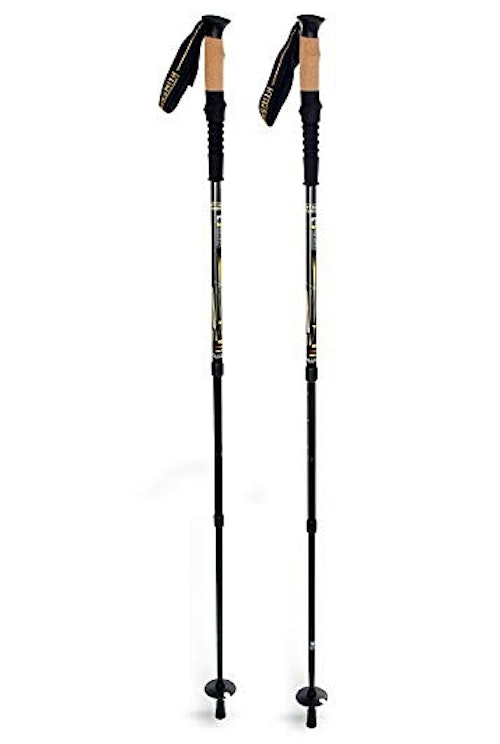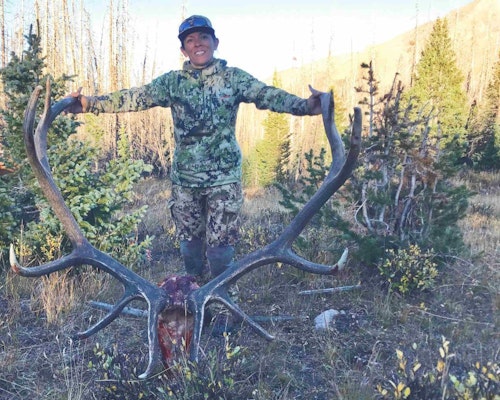Recently, I enjoyed an elk hunt in the remote wilderness of southwest Colorado. My goal for the hunt was to fill my freezer with natural, steroid-free meat, which I did. It wasn’t a walk in the park, however.
The San Juan Mountains are rugged! Elevations extend more than 14,000 feet above sea level. Slopes are steep; it’s not uncommon to gain 2,000 feet in elevation over a mere quarter-mile run. Above timberline, even the most well-used trails are shaped from talus, shale rock. Here — even in my best boots — traction is limited.
I remember a day when most people thought of trekking poles as tools for the old or the indigent. In fact, I still rarely hear them mentioned as a hunting tool. Trust me when I say not only can they make any jaunt more enjoyable and safe, but they’re a requirement in the terrain I hunt.
On this hunt, I put Mountainsmith’s Carbonlite Pro trekking poles to the test. Crafted from lightweight blended carbon and aircraft-grade 7075 aluminum, these rugged poles are well equipped for the mountain hunter.
Hunting Use
As I mentioned, trekking poles are a relative newcomer to the hunting market. Therefore, it’s quite possible that a customer is not aware they exist, or if they know, may not know the full gamut of their provisions. Below are a few basic ones.
An additional point (or two) of contact with the ground, reduces strain on body and joints. Under a heavy load — packing out a massive bull elk in Colorado — the added points of contact provide added stability and balance, possibly preventing injury. Trekking poles also come in handy when the ground is wet and slippery. In addition, crossing streams or traversing wet rocks is much safer with a solid pole set in hand.
Trekking poles provide balance, stability and energy conservation on adventurous treks. Once a hunter grows accustom to the idea of an ultra-light, collapsible, shock-absorbing, comfortable tool, they’ll likely never be without them. In fact, they may just provide that needed edge to get to try a backcountry hunt, get to that next vista or to fill a coveted tag.
Selling Points of Mountainsmith’s Carbonlite Pro Trekking Poles
Here are a few core features of the Carbonlite Pro trekking poles that you’ll want to highlight for your customers.
- Adjustment: Poles need to fit the user comfortably. A proper fit is determined by gripping the handle with the elbow bent at 90-degrees (forearm parallel to the floor or ground). The tip of the pole should rest on the ground. Mountain Smith trekking poles have three telescoping sections. They have double-cam twist-lock adjustments, which are quiet and simple to adjust. The collapsed length is 27 inches and fully extended length is 55 inches. Measurement increments are marked in inches and centimeters on each pole, making it a breeze to set equal lengths. The range adjustment makes sharing easy. This can come in handy on a heavy pack out. Additionally, they stow easily during transport. A clamp-on double U-bracket connects the poles together in a snap for easy storage and carrying.
- Grips: There is not much variation in grip material of trekking poles. In most cases, it’s cork, plastic or foam rubber. The Carbonlite Pro poles utilize extended cork/EVA/TRP handles. Many hunters prefer cork grips because after moderate use they will form to the user’s hands. Other plastic and rubberized grips come pre-formed and may not provide a custom fit.
- Weight: To prevent bicep and shoulder fatigue, a lightweight pole is best. True to their name, the Carbonlite Pro poles have carbon fiber upper sections, reducing the weight of a pole significantly. Added aluminum inserts in the lower sections give the poles strength and rigidity.
- Wrist Straps: Allow for hand use without releasing the pole to the ground. High-quality straps are handy for adding a location mark to a GPS or looking through binos to view game along the way. The Carbonlite Pros have adjustable soft-touch webbing wrist straps that will not chaff or cut into the skin. They’re made of a lightweight, durable, moisture-wicking fabric that are quick drying.
- Anti-vibration: An anti-vibration system absorbs impact as the pole hits the ground, preventing repetitive jarring of the wrist and elbows. The Carbonlite Pro poles are designed with a spring loaded anti-shock system with a lockout feature to reduce felt joint vibration.
- Boots: Part of the anti-vibration system is the rubber tip, or boot, at the tip of the pole. Having a boot is important for traction and impact dampening. Mountainsmith went even further. The shock-absorbing boot is removable and you’ll find a metal tip for winter quests or when a more aggressive bite is needed.
- Askets: Askets (snow baskets) provide trekking poles that crossover from simple hiking use to winter snow-shoe use. Askets are more common on ski poles. The Carbonlite Pro poles come with removable hiking askets, a pin locks them in place during use. Askets help keep the pole on the upper crust or surface of the snow. Being removable is important for non-snow use, keeping the tip from becoming tangled in brush or weeds, causing strain to the user.
Carbonlite Pro Trekking Poles Features
- Molded cork/EVA handle
- Three telescoping sections
- Spring loaded anti-shock system
- Twist lockout double-cam adjustment
- Removable hiking askets with locking pin
- Removable rubber boot tips
- Adjustable neoprene wrist strap
- Snow basket compatible
- Max Load: Up to 160 lbs
- Weight: 1 pound, 4 ounces
Materials
- Carbide Tips
- Carbon wrapped 7075 aluminum
MSRP
$79.95 (priced and sold as a pair)
Contact: www.mountainsmith.com
Pro Staff
Mia Anstine (below) grew up in the mountains along the San Juan River in southwest Colorado. She is a hunting guide, freelance writer, podcast host, commentator, public speaker, hunter education instructor, as well as an archery and firearms instructor. She shares her experiences to inspire others to embrace the outdoors.









